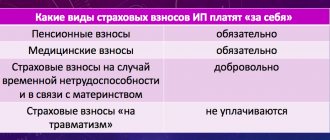If you use hired labor, you are required to insure your employees with four types of insurance: pension, medical, social, and against industrial accidents and occupational diseases. In this article we will talk about the latter.
Contributions from accidents, or in other words “for injuries,” must be paid monthly to the Social Insurance Fund. If an employee is injured at work or develops an occupational disease, he will receive compensation from the contributions that the employer contributed to the Fund.
This applies to employees who work under employment contracts. Insurance of employees hired under civil contracts for the provision of services or performance of work is a voluntary matter for the employer. He may or may not stipulate the obligation to pay insurance premiums in the GPC agreement. If he doesn’t register it, then he’s not obligated to make payments for injuries.
Registration with the Social Insurance Fund
Any newly created organization is automatically registered with the Social Insurance Fund after registration. The organization does not have to take any action for this - all data will be sent to the Fund by the tax office.
Individual entrepreneurs are not automatically registered. While the individual entrepreneur works alone, he does not owe the FSS anything. As soon as an entrepreneur enters into a first employment contract, he must within 30 calendar days to be registered, and then deduct contributions from employees’ salaries.
How to reflect the calculation of fixed insurance premiums for individual entrepreneurs in the 1C Bukh 3 program?
The procedure for calculating fixed insurance premiums for 2014 and 2020, 2020
Amount of contribution to the Pension Fund = minimum wage * 12 * 26%
Amount of contribution to the Compulsory Medical Insurance Fund = minimum wage * 12 * 5.1%
where the minimum wage (Minimum Wage):
- 5554 rubles in 2014
- 5965 rubles in 2020
- 6204 rubles in 2020
Thus, the amounts of insurance premiums are equal to:
- For 2020 - RUB 23,153.33.
- For 2020 - RUB 22,261.38.
- For 2014 - 20,727.53 rubles.
Also, starting from 2014, when receiving more than 300,000 rubles in income per year , the individual entrepreneur is obliged to pay 1% to the Pension Fund of the Russian Federation on the amount exceeding 300,000 rubles. For example, when receiving an income of 400,000 rubles, 1% must be paid on the amount of 400,000 - 300,000 = 100,000 rubles, we get 1,000 rubles.
BUT The law provides for a limitation on the amount of insurance contributions to the Pension Fund . Insurance premiums cannot exceed the product of eight times the minimum wage at the beginning of the year and the Pension Fund tariff, increased by 12 times. That is, for 2014, the maximum amount of contributions to the Pension Fund is 138,627.84 rubles. (5554 x 8 x 26% x 12).
Calculation of insurance premiums for an incomplete year
When paying the insurance premium for an incomplete year (when starting a business activity not from the beginning of the year or when terminating the activity), the amount of the contribution is correspondingly reduced in proportion to calendar days. Formula for calculation:
Minimum wage × M × Tariff + minimum wage × D/P × Tariff
- M & number of full months of activity of the individual entrepreneur in the reporting year;
- D & number of days in an incomplete month (the day of registration / termination of activity MUST be included);
- P & number of calendar days in this month;
In the 1C program to reflect the payment and accrual of fixed contributions and additional fees. There is no need to make any special settings.
The individual entrepreneur’s chart of accounts for settlements with the budget provides for:
- PFR - special sub-account 69.06.5 “Compulsory pension insurance for entrepreneurs”
- MHIF - subaccount 69.06.3 “Contributions to the MHIF.”
The main thing is to correctly fill out the document “Write-off from the current account”:
Fixed insurance premiums
its wiring:
And from incomes over 300,000 thousand rubles. Set the type of insurance premiums as: Insurance premiums calculated from the amount of income
The wiring will be like this:
For the MHIF:
Wiring
“Calculation of insurance premiums for individual entrepreneurs” will be performed.
Closing the month - Operation “Calculation of insurance premiums for individual entrepreneurs” reflects the insurance premiums paid during the year in accounting and tax accounting. The operation is performed once a year or once a quarter, depending on the applied taxation system and the availability of employees. In the case of applying a general taxation system or a simplified system with the object of taxation “income reduced by the amount of expenses”, the amount of paid insurance premiums is reflected in tax accounting as expenses.
It will create the following transactions for calculating insurance premiums for individual entrepreneurs:
And most importantly, remember: Fixed contributions must be paid before December 31 , additional ones (over 300 rubles) before April 1 of the following reporting year!
Amount of contributions
The amount of contributions depends on the hazard class of the work and varies in 2019 from 0.2% to 8.5% of wages.
The occupational risk class depends on OKVED and is determined on the basis of the Classification approved by Order of the Ministry of Labor of Russia No. 851n dated December 30, 2020. There are a total of 32 hazard classes on the list.
A company can conduct different types of business with different hazard classes, but the contribution rate for all company employees will be the same.
Calculate insurance premiums for employees online
When the FSS receives data on a newly registered enterprise or an entrepreneur-employer registers, the Fund’s employees look at what type of activity of the individual entrepreneur or company is indicated as the main one. It is by this OKVED code that they determine the hazard class and the amount of contributions. A notification is sent to the individual entrepreneur or company, informing them of the assigned hazard class.
Attention! If such a notification has not been received, this does not mean that there is no need to pay insurance premiums. Call your local Foundation office to inquire about rates.
In Article 20.2 of Federal Law 125-FZ of July 24, 1998 . “On compulsory social insurance against accidents at work and occupational diseases” lists payments that are not subject to contributions. These are government benefits, compensation payments, some types of financial assistance, etc.
If you conducted a special assessment of working conditions or spent money on improving working conditions, part of these expenses can be offset against the payment of contributions “for injuries” in accordance with clause 6 of clause 1 of Art. 18 of Law No. 125-FZ , clause 3 of the Rules approved by Order of the Ministry of Labor dated December 10, 2012 No. 580n . To do this, contact the Social Insurance Fund before August 1 with an application and financial plan. If you do not have overdue reports and arrears in contributions, you can count on funding for activities from the Social Insurance Fund in the amount of 20% of the amount of contributions paid last year.
GLAVBUKH-INFO
Question: How can an individual entrepreneur keep records of fixed insurance premiums in the 1C accounting program 3? What settings need to be made in order to calculate and transfer insurance premiums? Answer: Legislative framework: Starting from January 1, 2014, individual entrepreneurs pay insurance premiums for themselves according to the following scheme:Fixed contributions in 2014 until December 31, 2014: • to the Pension Fund of the Russian Federation - 17,328.48 rubles. • in FFOMS - 3399.05 rubles. Additional contributions to the Pension Fund if income for the year exceeds 300,000 rubles: • Pension Fund - in the amount of 1% of the amount over 300,000 rubles, but not more than the limit (PFR from 8 minimum wages) 142,026.89 rubles. Program 1C: 8 ed. 3: In the 1C program, no special settings need to be made to reflect the payment and accrual of fixed contributions and additional contributions. In the chart of accounts of individual entrepreneurs for settlements with the budget, the following are provided: • in the Pension Fund of the Russian Federation - a special subaccount 69.06.5 “Compulsory pension insurance of an entrepreneur” • in the Compulsory Medical Insurance Fund - subaccount 69.06.3 “Contributions to the Compulsory Medical Insurance Fund”. When transferring contributions to the budget, it is necessary to correctly fill out the document “Write-off from the current account” (Figure 1).
Postings will be made to reflect the transfer of contributions: • Fixed contributions to the Pension Fund (Figure 2).
• Fixed contributions in (Figure 3).
• Additional contributions to the Pension Fund (Figure 4).
Further, at the end of the year, the program, during the Month Closing procedure, will accrue paid insurance premiums “for itself” and automatically generate the document “Calculation of insurance premiums for individual entrepreneurs” (Figure 5).
If OSNO or simplified tax system is used (object “Income minus expenses”), the amount of insurance premiums paid will be reflected as expenses automatically. At the end of the year, the program Closing the month Operation “Calculation of insurance premiums for individual entrepreneurs” reflects the insurance premiums paid during the year in accounting and tax accounting. The operation is performed once a year or once a quarter, depending on the applied taxation system and the availability of employees. In the case of applying a general taxation system or a simplified system with the object of taxation “income reduced by the amount of expenses”, the amount of paid insurance premiums is reflected in tax accounting as expenses.
In the chart of accounts for individual entrepreneurs in 1C: When taking into account calculations of insurance premiums paid based on the cost of the insurance year, the account is used: 69.06 “Calculations for insurance premiums paid based on the cost of the insurance year” Additionally, payment is made until April 1, 2020, if income exceeds 300,000 rubles: • Pension Fund - in the amount of 1% of the amount over 300,000 rubles, but not more than the limit (PFR from 8 minimum wages) 142,026.89 rubles.
| Next > |
Confirmation of main activity
Legal entities must confirm their main type of activity every year. To do this, before April 15, they send to the Social Insurance Fund an application confirming the main type of economic activity and a confirmation certificate, which calculates the share of business types in total income. The main one for the current year will be the one according to which the company received the greatest income. If the incomes according to two OKVEDs coincide, the one with the higher hazard class will be taken as the main one.
Within two weeks after this, the territorial branch of the FSS of Russia will report on the tariff established since the beginning of this year. If the rate differs from the one that was in effect last year, the organization will have to recalculate the contributions that it has already accrued and transferred since the beginning of the current year.
What happens if an organization ignores the obligation to confirm the type of activity, or does it later than expected?
There is no penalty for failure to submit confirmation, but it can still cost the employer a pretty penny. The fact is that without receiving confirmation, the Social Insurance Fund will determine the contribution rate for the current year according to the OKVED code listed in the Unified State Register of Legal Entities that corresponds to the highest risk class, even if this activity is not the main activity for the company. The company will no longer be able to reduce the tariff until the end of the year. But if the company already conducts its main activities with the highest risk class, then without submitting confirmation it does not risk anything, because and so pays contributions at the maximum rate.
If the organization did not operate in the reporting year, it still needs to confirm its main type of activity, otherwise, when resuming activities, it will have to pay insurance premiums for employees at the maximum rate.
Individual entrepreneurs do not confirm their main activity. But if, in the process of work, the individual entrepreneur changes the main OKVED in the Unified State Register of Entrepreneurs, this will need to be reported to the Social Insurance Fund in order to change the tariff.
Calculation of contributions taking into account discounts or surcharges
The FSS of Russia can set a tariff for the current year taking into account a discount or surcharge.
If an organization (a separate division) has established a tariff taking into account the surcharge, then start using it from the beginning of the calendar year following the one in which the surcharge was established. Calculate your tariff contributions taking into account the discount from the beginning of the calendar year following the year the discount was established. This is stated in paragraph 10 of the Rules, approved by Decree of the Government of the Russian Federation of May 30, 2012 No. 524.
Calculate your insurance premiums against accidents and occupational diseases as follows:
| Contributions for insurance against accidents and occupational diseases | = | Monthly amount of payments recognized as subject to taxation by insurance premiums, per organization (separate division) | × | Tariff established by the organization (separate division) |
Actions of an accountant when resetting insurance premiums
The company is included in the register of SMEs and operates in one of the most affected industries, it will receive a benefit for the 2nd quarter of 2020 in the form of a zero tariff for all types of insurance premiums.
In circumstances where April contributions have already been accrued and paid at regular rates, the accounting entries must be reversed. To do this, you can use the reversal method in accounting.
Reducing costs in accounting is achieved through the relationship of reversal and cancellation of a previously paid contribution.







